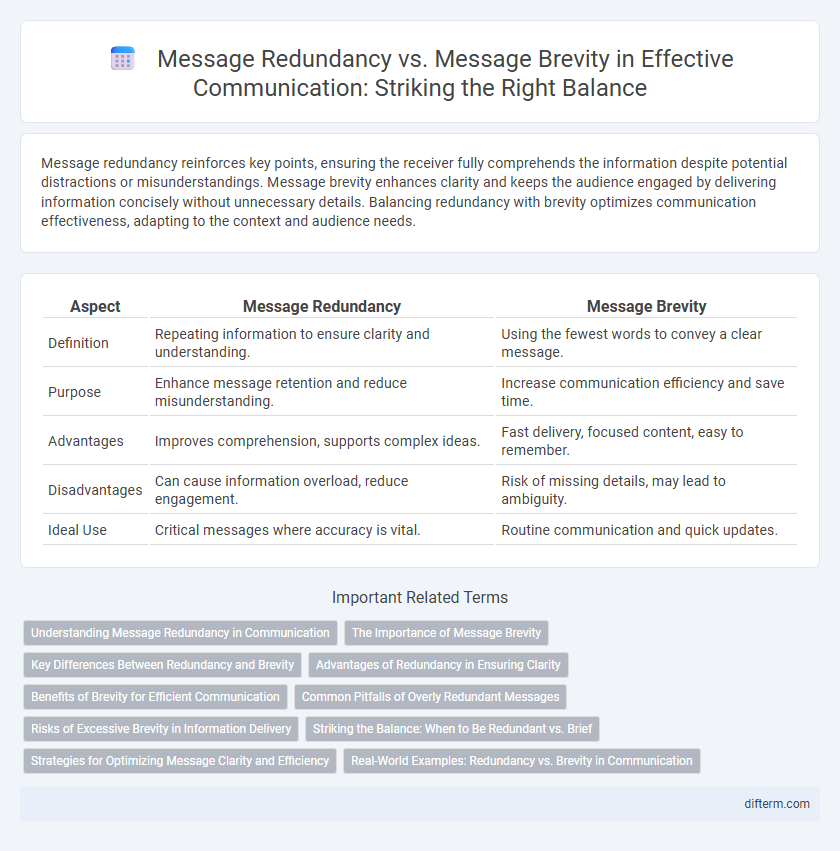Message redundancy reinforces key points, ensuring the receiver fully comprehends the information despite potential distractions or misunderstandings. Message brevity enhances clarity and keeps the audience engaged by delivering information concisely without unnecessary details. Balancing redundancy with brevity optimizes communication effectiveness, adapting to the context and audience needs.
Table of Comparison
| Aspect | Message Redundancy | Message Brevity |
|---|---|---|
| Definition | Repeating information to ensure clarity and understanding. | Using the fewest words to convey a clear message. |
| Purpose | Enhance message retention and reduce misunderstanding. | Increase communication efficiency and save time. |
| Advantages | Improves comprehension, supports complex ideas. | Fast delivery, focused content, easy to remember. |
| Disadvantages | Can cause information overload, reduce engagement. | Risk of missing details, may lead to ambiguity. |
| Ideal Use | Critical messages where accuracy is vital. | Routine communication and quick updates. |
Understanding Message Redundancy in Communication
Message redundancy in communication involves repeating key information to enhance clarity and ensure the receiver accurately comprehends the message, particularly in complex or critical contexts. This technique mitigates misunderstandings caused by noise, distractions, or ambiguous wording by providing multiple cues or varied expressions of the same idea. Although it may increase message length, redundancy strategically reinforces understanding, making it essential in fields like emergency response and technical instructions.
The Importance of Message Brevity
Message brevity enhances communication effectiveness by delivering clear, concise information that reduces cognitive load and prevents message dilution. Research shows that concise messages improve comprehension and retention, especially in fast-paced environments where attention spans are limited. Prioritizing brevity encourages active listening and accelerates decision-making, making it a critical strategy in professional and digital communication.
Key Differences Between Redundancy and Brevity
Message redundancy involves repeating information to ensure clarity and reinforce understanding, which can prevent miscommunication in complex contexts. Message brevity focuses on concise communication, eliminating unnecessary words to enhance clarity and efficiency, ideal for fast-paced or digital environments. The key difference lies in redundancy prioritizing thoroughness and assurance, while brevity emphasizes succinctness and time-saving.
Advantages of Redundancy in Ensuring Clarity
Message redundancy enhances clarity by reinforcing key points through repetition, reducing the chance of misinterpretation in communication. It provides multiple pathways for the receiver to understand the message, especially in noisy or complex environments. This technique increases information retention and ensures that critical details are conveyed even if some parts are overlooked.
Benefits of Brevity for Efficient Communication
Brevity in communication enhances clarity by reducing unnecessary information, enabling messages to be understood quickly and accurately. It saves time for both the sender and receiver, increasing overall efficiency in conversations and decision-making processes. Concise messages also minimize cognitive load, which helps maintain the audience's attention and improves retention of key points.
Common Pitfalls of Overly Redundant Messages
Overly redundant messages often lead to audience disengagement due to information overload and decreased message clarity. Repetition without added value can dilute the core message, causing misinterpretation and reduced retention. Effective communication balances necessary reinforcement with concise, precise language to maintain attention and drive understanding.
Risks of Excessive Brevity in Information Delivery
Excessive brevity in information delivery can lead to misunderstandings, as critical details may be omitted, resulting in ambiguity and confusion. Important context or nuances might be lost, increasing the risk of misinterpretation and reducing message effectiveness. This can compromise decision-making processes and weaken overall communication clarity in professional settings.
Striking the Balance: When to Be Redundant vs. Brief
Striking the balance between message redundancy and brevity enhances communication effectiveness by ensuring clarity without overwhelming the audience. Redundancy is crucial when conveying complex or critical information to reinforce understanding and retention, particularly in technical or safety communications. Brevity serves well in fast-paced contexts or when addressing experienced stakeholders, maintaining engagement and preventing information overload.
Strategies for Optimizing Message Clarity and Efficiency
Message redundancy enhances communication clarity by reinforcing key points, reducing the risk of misunderstanding, and ensuring the receiver accurately interprets the intended meaning. Message brevity improves efficiency by conveying essential information concisely, minimizing cognitive load and saving time. Balancing redundancy and brevity through strategic repetition and precise wording optimizes message clarity while maintaining concise delivery.
Real-World Examples: Redundancy vs. Brevity in Communication
In customer support, message redundancy ensures clarity by reiterating key instructions, reducing misunderstandings in complex troubleshooting steps. Conversely, in emergency alerts, message brevity is critical to deliver essential information quickly, preventing delays that can affect safety outcomes. Marketing emails strike a balance by using concise language while repeating vital calls to action to enhance engagement and conversion rates.
Message redundancy vs Message brevity Infographic

 difterm.com
difterm.com